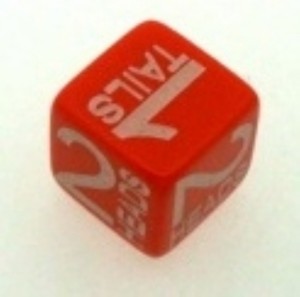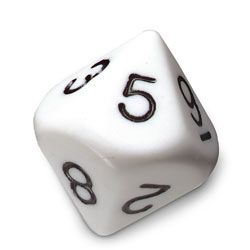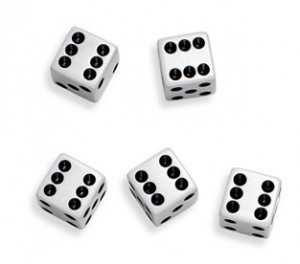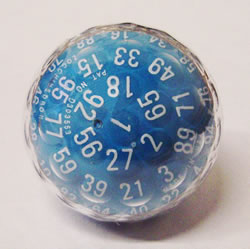My sister and I would often spend hours around my granny’s kitchen table playing the game of Yahtzee. If you never played the game, it involves rolling 5 dice to score various points. The greatest amount you could score on a sheet was a Yahtzee in which all five dice showed the same number.
The probability of rolling a Yahtzee with the first roll of the dice is calculated by multiplying each dice’s probability together. 1/6 * 1/6 * 1/6 * 1/6 * 1/6 = 0.00014 or 0.014%. Each roll would only have a 0.014% chance of rolling all equal dice. This means that it is very rare that one person would roll a Yahtzee on the first try. But what if you roll all the dice 100,000 times, what then of the probability of getting Yahtzee? Well, it is likely that 14 rolls would produce such a result, although if you carried out this experiment over and over again, you would get a normal distribution clustering around 14 rolls of the dice, but there would be a good guarantee that at least one of those hundred thousand rolls you would roll a Yahtzee. I would often sit at the table long after the game was over, attempting such a feat. I remember only two games in which a Yahtzee was initially rolled the first time in all my Yahtzee playing days.
In 1961 a group of scientists devised a similar game of chance— a cosmic game of Yahtzee! The inventor of this particular game was a man named Frank Drake, but among the group of scientists was the young Carl Sagan (hence a truly cosmic game). The game was also played with five dice, which would be rolled all together many times. Just like Yahtzee, but these dice are not your typical six sided dice, they are multi-sided. Now what makes this game of Yahtzee truly cosmic is that rather than yelling Yahtzee, and besting your sister at the game, if all dice equaled the same number you would have a planet inhabited by an alien civilization with the capacity to communicate using radio-waves. And the number of rolls of dice would be equal to the stars within our Milky Way galaxy, about 300 billion turns at rolling all the dice.
If each of the dice only had six sides a piece you would be guaranteed that with 300 billion rolls, you would have a Yahtzee. So the universe must be bountiful in alien life, however these dice don’t just have six sides. Each dice represents the individual chances leading up to the evolution of intelligent life with advanced technology that could communicate with us that might be behind every star.
 The first dice that Frank Drake designated was called fp the number of stars with planets. Initially the scientists decided to use a four sided dice. However, since then we’ve discovered that most stars contain planets. Especially given the remarkable discoveries made by the Kepler Telescope. In fact, rather than a four sided dice, I think we can use a two sided dice (we could flip a coin). Some even argue that we could even skip using a dice; behind every star there is at least one planet. But we will use a two sided dice (or coin flip).
The first dice that Frank Drake designated was called fp the number of stars with planets. Initially the scientists decided to use a four sided dice. However, since then we’ve discovered that most stars contain planets. Especially given the remarkable discoveries made by the Kepler Telescope. In fact, rather than a four sided dice, I think we can use a two sided dice (we could flip a coin). Some even argue that we could even skip using a dice; behind every star there is at least one planet. But we will use a two sided dice (or coin flip).
Originally this next dice was called ne the number of planets within a solar system that can support life. Although we can re-frame this dice here as the number of stars with an Earth-like planet sufficient enough to support life. Now we know from our solar system that only Earth can currently support life. Given that we have seven planets (excluding the dwarf planets), then a 1/7th chance exists that one of the planets would lay within the nice spot within the triple junction point for gas, liquid and solid water to exist together. In looking at newly discovered exoplanets (planets in other solar systems), this faction is likely remarkably less, and no life has been found in any orbiting moon, and no evidence of life ever having existed on Mars, even from its more equitable deep past, when liquid water raced across its surface when Mars contained a thicker atmosphere. In truth a lot of things need to be perfect, not too hot and not too cold, not too heavy and not too light.
The plane t must be around the size of Earth, be relatively distant from its sun, and orbit in such a manner that it is evenly cooked. No slow rotations like Venus allowed. As of today March 12, 2014, there are 4241 exoplanets, if we add our 7 planets to the mix, we have 4248 planets currently spinning around stars. Of these only about 42 are similar size to Earth, and likely only 4 with the correct spin and chemistry to possibly harbor life. A good estimate is that 1 out of 100 planets are possible places were life could exist. These planets may not support life from Earth, but hold enough ingredients that life could exist and originate on the planet. If each distant star had an average of 10 planets, so let us have this dice be a 10 sided dice.
t must be around the size of Earth, be relatively distant from its sun, and orbit in such a manner that it is evenly cooked. No slow rotations like Venus allowed. As of today March 12, 2014, there are 4241 exoplanets, if we add our 7 planets to the mix, we have 4248 planets currently spinning around stars. Of these only about 42 are similar size to Earth, and likely only 4 with the correct spin and chemistry to possibly harbor life. A good estimate is that 1 out of 100 planets are possible places were life could exist. These planets may not support life from Earth, but hold enough ingredients that life could exist and originate on the planet. If each distant star had an average of 10 planets, so let us have this dice be a 10 sided dice.
The next dice we have is called fl which is the fraction of planets that develop life. This dice is particularly difficult to figure out how many sides it might have. Life on Earth originated very early in its history between 3.8 and 3.5 billion years ago. The oldest Archaean microfossils appear at 3.496 billion years ago, and by 3.0 billion years ago fossil stromatolites become abundant. Hence, life originated early on Earth, but has it originated multiple times? It is difficult to say at this time. The famous Urey-Miller experiment indicates that at least amino acids are easily produced naturally, and recent experiments show that natural synthesis of RNA is possible. Hence, I think we could use a dice with just a few sides. Some scientists suggest that life would inevitably originate on a planet given the right conditions, such as the optimum distance from the sun, and starting ingredients. I’m a little more skeptical, and suggest using a regular 6 sided dice.
 If we want to stop here, to play our game than the chance of finding a planet with life is rather high: 1/2 * 1/10 * 1/6 = 0.008, which means that 0.8% change of life would exist with each star in the sky. These odds are much greater than rolling a Yahtzee on the first roll. For each 100,000 stars in the galaxy, there are likely 800 with life. With 2.4 billion planets with life!
If we want to stop here, to play our game than the chance of finding a planet with life is rather high: 1/2 * 1/10 * 1/6 = 0.008, which means that 0.8% change of life would exist with each star in the sky. These odds are much greater than rolling a Yahtzee on the first roll. For each 100,000 stars in the galaxy, there are likely 800 with life. With 2.4 billion planets with life!
But these are mostly just slimy planets. Slimy planets are ones that harbor life, but this life is just self-replicating chemical stews of single celled organism growing from energy (either star energy or energy from the core of the planet) and chemical reactions, likely involving chains of carbon bonded in polymers. In other words just slime.
The next dice is the most important one, fi which is the number of life forms that develops intelligence. This is hard to define. What is intelligence? Many animals have intelligence, but we are looking at a particular chance that this intelligence leads to technology.
So let’s look at life in total here on Earth, to see which species meet the criteria of intelligence. First this life must be multicellular— large enough to manipulate the world around it. Most of life is single celled, small prokaryotic cells, like bacteria. It is estimated that there are 8.7 million species of life on our planet, although this is a grossly inaccurate estimate, let’s use 10 million species, but what about the fossil record? Steven J. Gould famously stated that 99.9% of species are extinct ones, so we can increase this number with the fossil record. So we get 10 billion species throughout time. What faction of these 10 billion species are intelligent? My cat is intelligent, he is able to get me to feed him, and smart enough to provide me companionship, so what percentage of these planets with life have creatures as intelligent as a house cat? Cats belong in mammals, and there are about 5,600 living species of mammals, if we include some intelligent insects, and other invertebrates then our number grows to about 10,000 intelligent species. So a 1 in a million chance. A dice with a million sides! (note they don’t make dice with a million sides, the largest dice has 100 sides)
(I can’t even imagine a 1 million sided dice!)
But how long did it take to have these more advance species evolve through time. The fossil record shows that multicellular organisms did not appear until about 2.8 billion years after life had first appeared. Multicellular organisms are remarkably rare. The catalyst for the first appearance of multicellular organisms might have been related to the claustrophobic freezing of the Earth’s oceans— pooling all living organisms within a small geographic region along the equator. In addition, life leads to pollution, and early life on Earth polluted the atmosphere by adding large quantities of oxygen and removing carbon dioxide— continually cooling the planet further. In fact Peter Ward and Donald Brownlee argue that once a planet runs through its supply of carbon dioxide, life is extinguished for good. So there needs to be a source of carbon dioxide, through volcanoes. Plate tectonics is necessary. Carbon must be in supply. If a planet is found to have large amounts of carbon dioxide in its atmosphere, it is a sure sign of a vacancy sign regarding life. These chances make it remarkably slim that life would exist long enough to develop into multicellular organisms, and that such occurrences are rare. However, in the history of Earth, there are a number of examples of single celled prokaryotic organisms coming together in a symbiotic relationship, so perhaps it is not as rare as we might think. If we go with a million sided dice, you can see how very important this dice roll is regarding the outcome of our game. It is the trickiest one!
If we want to stop here, to play our game we find that the chance of finding a planet with intelligent life is getting rather low: 1/2 * 1/10 * 1/6 * 1/1,000,000 = 0.0000000008. With 300 billion stars, there are 2,400 planets with intelligent life, or as intelligent as my cat. I think this is really amazing. What weird and strange creatures might exist on these planets? We may never know, because as much as I love my cat, I don’t think he will ever search the stars for aliens. Of these planets, few will have the capacity to be driven by technology enough to seek the cosmos for a neighbor. Like my cat, these worlds would not answer the door, even if you rang the bell.
Our last dice of the game is call fc which is the fraction of intelligent life that develops technology to transmit radio-wave communications. If we look at humans, as one species among 10,000 intelligent species, which have achieved this technology, then the probability is 1/10,000 or a ten thousand sided dice. Technology needs not only intelligence, but the manual ability to manipulate the world, and the knowledge to build something which requires a complex social interaction among individuals, of one or multiple species. Our ten thousand sided dice is a fairly optimistic number, it may be something on the order of hundred thousand.
(add another imaginary dice to the game with 10,000 sides!)
So again we return to our game, and find the chance growing dimmer of finding a technically advance civilization in our galaxy. 1/2 * 1/10 * 1/6 * 1/1,000,000 * 1/100,000 = 8 x 10-16 which is 8 with 16 zeros in front of it. But wait, we have 300 billion rolls with our cosmic dice game, surely one of those is likely to strike it. When we multiply 300 billion to this very small number, we get 0.00024, which means that it is very unlikely that there is a planet out there with the technology to communicate with us.
There is one other dice brought into this game, and that is the L dice, which represents the length that such a technological civilization would exist. For this we can use the average duration of a typically mammal species, which is about 1.5 million years divided by the course of a planet’s total history. So about 1/10,000 or a ten thousand sided dice. Some scientists are not as optimistic about our survival, war and political differences are likely to make this dice even more multi-sided, but I’m confident that species will keep the search going.
(Oh, you are really not making this game easy, add another 10,000 sided dice to the game)
So if we add this wild card dice to the game (just like the Powerball in lottery) the probability goes even lower. 1/2 * 1/10 * 1/6 * 1/1,000,000 * 1/100,000 * 1/10,000 = 8 x 10-20, and with 300 billion stars, the chance is 0.00000024, which means that it is very very unlikely such a planet exists right now, trying to communicate with us.
This is the crux of the Rare Earth Hypothesis, that Earth for whatever marvelous and serendipity exists and it is likely the only one that exists in our galaxy.
Science has a way of knocking us down, to making us feel not really special after all. We are tiny flotsam of a cosmic ocean, but we are a highly improbable piece of flotsam, bobbing along on our way across the universe.
Perhaps chance itself will grant another miraculous roll of the dice. With each star generated within our galaxy another roll is made. The rate of star formation is about 7 stars a year, so every year 7 new rolls of the dice are made, and maybe someday we will strike it lucky, and yell Yahtzee, and do the funky chicken dance like I use to do in front of my sister when I won.
The knowledge of how rare the Earth is with its marvelous intelligent life infuses a great duty in protecting our shared planet. We must all come to realize how truly rare Earth is. And what a pleasure it is to grace its surface even for the briefest flashes of time.


